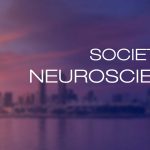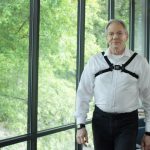A Novel Neuromodulation Intervention Improves Gait & Balance for Spinocerebellar Ataxia
Neuromodulation is a non-invasive or minimally invasive therapy that has been gaining popularity for relieving symptoms and restoring function across a wide range of chronic conditions. The International Neuromodulation Society defines therapeutic neuromodulation as “the alteration of nerve activity through targeted delivery of a stimulus, such as electrical stimulation or chemical agents, to specific neurological sites in the body [1].” Neuromodulation techniques can vary, but this type of therapy is commonly used for managing chronic pain, essential tremor, Parkinson’s disease, ataxia, cerebral palsy, stroke, traumatic brain injury, and more. Similar to the way a pacemaker corrects heartbeat abnormalities, pulses of electrical stimulation in the brain can help modulate abnormal neural pathways. As concerns increase in the medical community about adverse side effects from long-term exposure to pharmacological agents, doctors may consider neuromodulation therapy as an alternative or complementary solution.
Neuromodulation & Ataxia
The Australian Rehabilitation Research Centre at the Royal Melbourne Hospital wanted to investigate the efficacy of combining high-intensity physiotherapy with cranial-nerve non-invasive neuromodulation using a portable stimulator in a case with cerebellar degeneration. This novel approach has been recently applied in patients with multiple sclerosis, traumatic brain injury, and stroke survivors with positive results [2, 3]. For this study, a 55-year old woman who has suffered from a slow progressive spinocerebellar ataxia over the last 20 years was recruited to participate. The National Institutes of Health define spinocerebellar ataxia or SCA as a genetic disorder characterized by problems with balance, uncoordinated gait, poor hand-eye coordination, and abnormal speech [4]. This particular patient reported being a frequent faller due to her poor balance, with spasticity in her lower limbs being a major contributor. The goal of this novel intervention was to improve the patient’s gait and balance, thus providing her greater independence and quality of life.
The Intervention
The intervention consisted of two physiotherapy sessions per day, 1.5 hours per session (three hours between sessions) for two weeks (18 sessions in total plus pre- and post- intervention assessment sessions). Each session was structured in three blocks of 20 minutes, each focusing on gait performance, balance control and a relaxation/meditation period in the same order. During each block the patient used the portable neuromodulation stimulator (PoNS™) device at a comfortable intensity which could be adjusted by the patient or therapist. At least five minutes of rest were given between stimulation blocks.
Improvements in Gait & Balance
Gait and balance assessments were performed using APDM’s Mobility Lab gait and balance analysis system with Opal wearable sensors placed at various body site locations. Spatiotemporal measures were collected for the patient from a walk test with over 40 gait cycles and three postural sway tests. After two weeks of the intervention, the researchers found a significant increase in trunk range of motion and arm swing, while asymmetry of stride length and gait speed were decreased. The postural sway tests using “Double Support” and “Tandem Stance” conditions showed a large reduction in the patient’s jerk, sway area, and mean velocity. After the intervention, the patient was able to walk faster and maintain dynamic balance, all important objective values of general health and wellbeing [5].
Advancing Rehabilitation Research
APDM Wearable Technologies is a digital health company focused on advancing rehabilitation research by providing objective measures of human movement using wearable sensors. Learn more about integrating kinematic data into your research for sensitive and valid outcome measures of disease progression by visiting www.apdm.com.
References
- International Neuromodulation Society. Welcome to the International Neuromodulation Society. www.neuromodulation.com.
- Leonard, et al. “Noninvasive tongue stimulation combined with intensive cognitive and physical rehabilitation induces neuroplastic changes in patients with multiple sclerosis: a multimodal neuroimaging study.” Multiple Sclerosis Journal – Experimental, Translational, and Clinical, 2017.
- Galea, et al. “Cranial nerve non-invasive neuromodulation improves gait and balance in stroke survivors.” Brain Stimulation, 2017.
- National Institutes of Health. Genetic and Rare Diseases Information Center. https://rarediseases.info.nih.gov/diseases/10748/spinocerebellar-ataxia.
- Bastani, et al. “The combined effect of cranial-nerve non-invasive neuromodulation with high-intensity physiotherapy on gait and balance in a patient with cerebellar degeneration: a case report.” Cerebellum & Ataxias, 2018.





